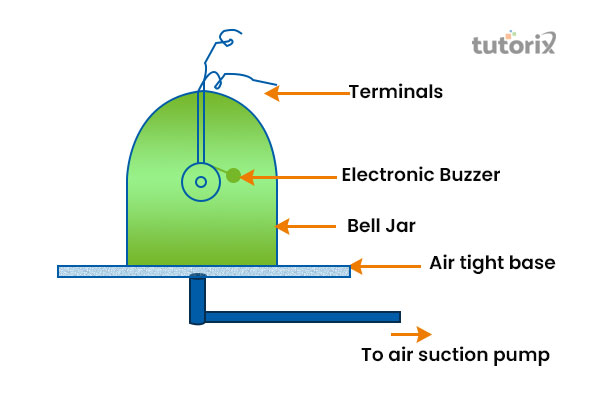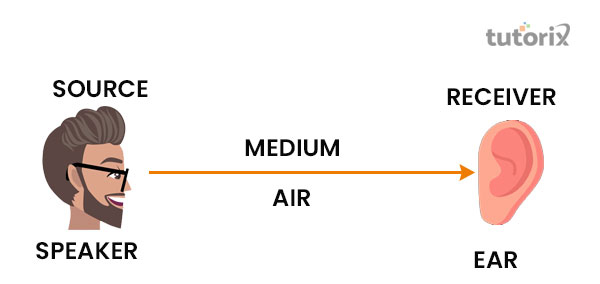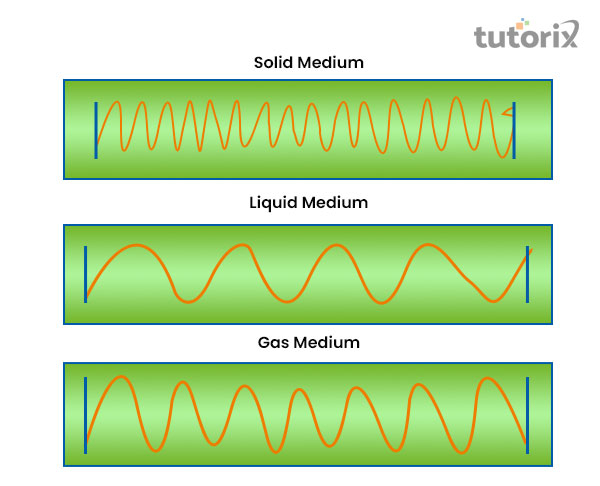

Sound refers to a particular form of energy that mainly produces a hearing sense in the ear. Sounds are mainly created because of the vibration of the objects as well as the movement of the air molecules. For example, the sounds that are created from the vocal cords and other sounds are made from the elastic body particle movements. Sound requires a medium, for instance, solid, air or liquid for travelling.
For this particular reason, they communicate with each other through the usage of "Communications Carrier Assembly" (CCA) as in space because in space there is no medium to carry the waves of sound.
The four different types of fundamental waves for sound propagation are commonly seen, air, liquid, solid as well as plasma medium.

Figure 1: The medium propagation for sound waves
In the different mediums, the speed and the wavelength of sound vary. For example, at 700F the speed of the sound is around 760 miles/hour, but when the temperature increases to more than 100 then the speed of the sound increases to about 800 miles/hour.
In the liquid medium at the temperature of 700F, the sound travels more than 3000 miles/hour but when the density of the sound increases, the wavelength of the sound becomes slower.

Figure 2: The propagation of sound
The solid medium represents the density, compressibility as well as rigidity that positively affects the speed of the sound.
For example, the speed of sound in the medium of iron that greater than the wood because of the density, compressibility as well as rigidity of the medium. In the solid medium, the speed of the sound is about 11500 miles/hour (Yan et al. 2020). In the solid medium, the speed of sound is higher even though it is better than the air. In the air medium, the speed of sound is around 8800 miles/hour.

Figure 3: Different wavelengths of sound in a different medium
In order to propagate the sound waves is the most significant particles that help to transfer the sound from the source to another medium.
Two different types of waves like longitudinal as well as transverse waves (Becker et al. 2018). The sound waves have also relied on the weather and the surrounding atmosphere (Darman et al. 2019). The solid medium is the best medium of transportation of sound because the molecules of the solid medium are very close to each other while in the other medium the molecules are a little far from other molecules.
Moreover, electromagnetic waves do not need a "medium to propagate" for transportation which means these particular waves do not only travel in the solid, liquid or gas medium but this kind of waves aslo passes through "the vacuum of space". The transverse waves do not need any kind of medium for the propagation as they can travel vacuum into space but the other types of waves are fully dependent on different mediums for the propagation.
Q1. What is the main reason for zero propagation of sound waves in a vacuum?
No molecules are present in a vacuum and sound waves do not have properties without any force of molecules. Therefore, the sound cannot propagate in a vacuum.
Q2. Why does the astronaut not talk into space.?
In space, any kind of molecule of any medium is present. Therefore, the astronauts use different instruments to communicate with each other.
Q3. What are the different types of waves of sound?
The different types of sound waves are radio waves, microwaves as well as infrared waves. Besides this, ultraviolet waves, X-ray and Gamma waves are also seen.
Q4. Do mechanical waves need a medium for sound propagation?
Yes, for the sound propagation the mechanical waves need a medium or the force of molecules. In contrast, to propagate an electromagnetic wave does not need any medium.
Bambic, C. J., & Reynolds, C. S. (2019). Efficient production of sound waves by AGN jets in the intracluster medium. The Astrophysical Journal, 886(2), 78. Retrieved from: https://iopscience.iop.org/
Becker, T. S., van Manen, D. J., Donahue, C. M., Bärlocher, C., Börsing, N., Broggini, F., ... & Blum, T. E. (2018). Immersive wave propagation experimentation: Physical implementation and one-dimensional acoustic results. Physical Review X, 8(3), 031011. Retrieved from: https://link.aps.org/
Darman, D. R., Wibowo, F. C., Suhandi, A., Setiawan, W., Abizar, H., Nurhaji, S., ... & Istiandaru, A. (2019, March). Virtual media simulation technology on mathematical representation of sound waves. In Journal of Physics: Conference Series (Vol. 1188, No. 1, p. 012092). IOP Publishing. Retrieved from: https://iopscience.iop.org/
Ramadhan, R. H., Ratnaningtyas, L., Kuswanto, H., & Wardani, R. (2019, December). Analysis of physics aspects of local wisdom: Long Bumbung (Bamboo Cannon) in media development for android-based physics comics in sound wave chapter. In Journal of Physics: Conference Series (Vol. 1397, No. 1, p. 012016). IOP Publishing. Retrieved from: https://iopscience.iop.org/
Yan, Q., Liu, K., Zhou, Q., Guo, H., & Zhang, N. (2020, February). Surfingattack: Interactive hidden attack on voice assistants using ultrasonic guided waves. In Network and Distributed Systems Security (NDSS) Symposium. Retrieved from: https://par.nsf.gov/
Websites
Meritnation (2022). About The medium propagation for sound waves. Retrieved from: https://www.meritnation.com [Retrieved on 17th June 2022]
Technature (2022). About The propagation-of-sound. Retrieved from: http://www.technature.ca/ [Retrieved on 17th June 2022]